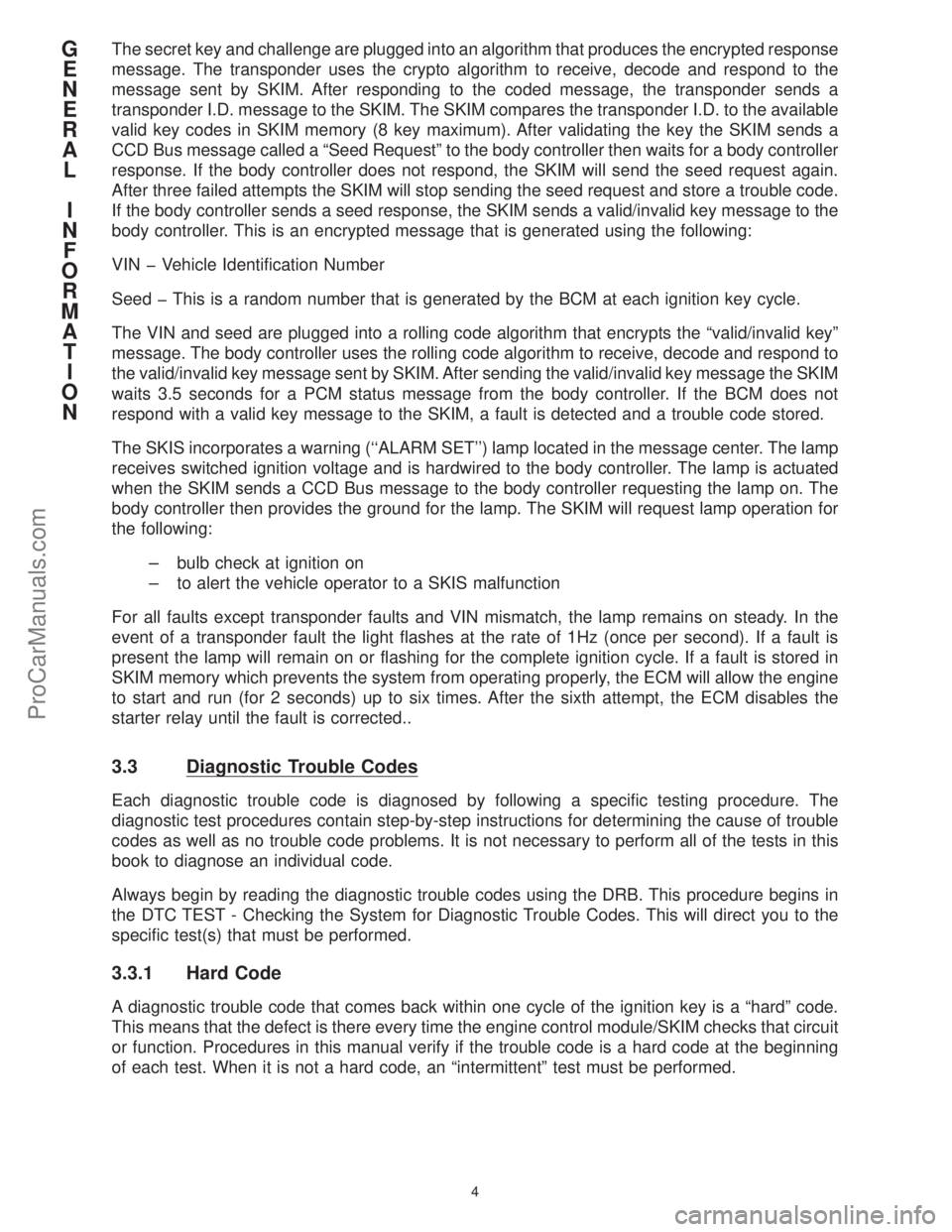check engine light CHRYSLER CARAVAN 2000 Service Manual
[x] Cancel search | Manufacturer: CHRYSLER, Model Year: 2000, Model line: CARAVAN, Model: CHRYSLER CARAVAN 2000Pages: 436, PDF Size: 3.4 MB
Page 10 of 436

The secret key and challenge are plugged into an algorithm that produces the encrypted response
message. The transponder uses the crypto algorithm to receive, decode and respond to the
message sent by SKIM. After responding to the coded message, the transponder sends a
transponder I.D. message to the SKIM. The SKIM compares the transponder I.D. to the available
valid key codes in SKIM memory (8 key maximum). After validating the key the SKIM sends a
CCD Bus message called a ªSeed Requestº to the body controller then waits for a body controller
response. If the body controller does not respond, the SKIM will send the seed request again.
After three failed attempts the SKIM will stop sending the seed request and store a trouble code.
If the body controller sends a seed response, the SKIM sends a valid/invalid key message to the
body controller. This is an encrypted message that is generated using the following:
VIN þ Vehicle Identification Number
Seed þ This is a random number that is generated by the BCM at each ignition key cycle.
The VIN and seed are plugged into a rolling code algorithm that encrypts the ªvalid/invalid keyº
message. The body controller uses the rolling code algorithm to receive, decode and respond to
the valid/invalid key message sent by SKIM. After sending the valid/invalid key message the SKIM
waits 3.5 seconds for a PCM status message from the body controller. If the BCM does not
respond with a valid key message to the SKIM, a fault is detected and a trouble code stored.
The SKIS incorporates a warning (``ALARM SET'') lamp located in the message center. The lamp
receives switched ignition voltage and is hardwired to the body controller. The lamp is actuated
when the SKIM sends a CCD Bus message to the body controller requesting the lamp on. The
body controller then provides the ground for the lamp. The SKIM will request lamp operation for
the following:
± ± bulb check at ignition on
± to alert the vehicle operator to a SKIS malfunction
For all faults except transponder faults and VIN mismatch, the lamp remains on steady. In the
event of a transponder fault the light flashes at the rate of 1Hz (once per second). If a fault is
present the lamp will remain on or flashing for the complete ignition cycle. If a fault is stored in
SKIM memory which prevents the system from operating properly, the ECM will allow the engine
to start and run (for 2 seconds) up to six times. After the sixth attempt, the ECM disables the
starter relay until the fault is corrected..
3.3 Diagnostic Trouble Codes
Each diagnostic trouble code is diagnosed by following a specific testing procedure. The
diagnostic test procedures contain step-by-step instructions for determining the cause of trouble
codes as well as no trouble code problems. It is not necessary to perform all of the tests in this
book to diagnose an individual code.
Always begin by reading the diagnostic trouble codes using the DRB. This procedure begins in
the DTC TEST - Checking the System for Diagnostic Trouble Codes. This will direct you to the
specific test(s) that must be performed.
3.3.1 Hard Code
A diagnostic trouble code that comes back within one cycle of the ignition key is a ªhardº code.
This means that the defect is there every time the engine control module/SKIM checks that circuit
or function. Procedures in this manual verify if the trouble code is a hard code at the beginning
of each test. When it is not a hard code, an ªintermittentº test must be performed.
G
E
N
E
R
A
L
I
N
F
O
R
M
A
T
I
O
N
4
ProCarManuals.com
Page 247 of 436

TEST TC-76AREPAIRING - SMART START RELAY SHORT CIRCUIT
Perform TEST DTC Before Proceeding
*Perform Verification TEST VER-1A. **Check connectors - Clean / repair as necessary.
REPLACE THE
START TEST STARTER RELAY WITH
TC-76A. A KNOWN GOOD
RELAY.
FIG.1
FULLY DEPRESS THE
CLUTCH PEDAL AND DOES THE ENGINE YES REPLACE THE
ATTEMPT TO CRANK CRANK? INITIAL STARTER
THE ENGINE RELAY.
NO
KEY OFF.
REMOVE THE STARTER REMOVE THE DIESEL
DISCONNECT THE ECM RELAY.** POWER RELAY.**
HARNESS
CONNECTORS.**
WITH A JUMPER WIRE, KEY ON. USING A REPAIR THE STARTER
CONNECT DIESEL POWER TEST LIGHT, PROBE IS THE TEST LIGHT YES RELAY CONTROL
RELAY CONN. CAVITIES THE STARTER RELAY ON? CIRCUIT FOR A
30 AND 87 (IN PDC). CONTROL CIRCUIT. SHORT TO VOLTAGE.*
FIG.1 FIG.1
NO
REPLACE THE ENGINE
CONTROL MODULE.*
T
R
O
U
B
L
E
C
O
D
E
T
E
S
T
S
241
ProCarManuals.com
Page 331 of 436

TEST NTC-2ACHECKING GLOW PLUG OPERATION
Perform TEST NTC-1A Before Proceeding
*Perform Verification TEST VER-2A. **Check connectors - Clean / repair as necessary.
THE 2.5L DIESEL GLOW PLUG RELAY #1 GLOW PLUG RELAY #2
START TEST ENGINE UTILIZES SUPPLIES POWER TO SUPPLIES POWER TO
NTC-2A. TWO GLOW PLUG THE GLOW PLUGS IN THE GLOW PLUGS IN
RELAYS... CYLINDERS #1 & #4. CYLINDERS #2 & #3.
PERFORM THIS TEST
ON GLOW PLUG RELAY
#1 THEN REPEAT TURN IGNITION OFF.
TEST FOR GLOW PLUG
RELAY #2.
DISCONNECT EACH KEY ON. USING THE
GLOW PLUG HARNESS DRB, ACTUATE THE
CONNECTOR. GLOW PLUG RELAY.
USING A TEST
LIGHT, PROBE THE DOES THE TEST NO TEST NTC-2A
APPROPRIATE GLOW LIGHT FLASH ON AND CONTINUED ON
PLUG HARNESS CONN. OFF? THE NEXT PAGE.
FIG.1 AND 2
YES
GLOW PLUG CIRCUITRY
OK. REFER TO SERVICE
MANUAL TO CHECK GLOW TEST COMPLETE.*
PLUG OPERATION.
N
O
T
R
O
U
B
L
E
C
O
D
E
T
E
S
T
S
325
ProCarManuals.com